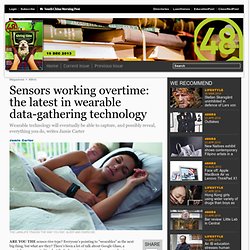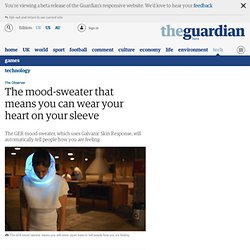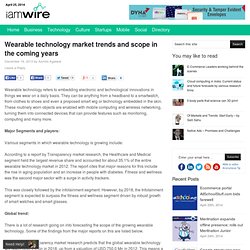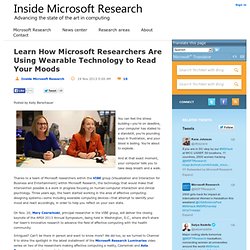

Sensors working overtime: the latest in wearable data-gathering technology. ARE YOU THE sensor-tive type?

Everyone's pointing to "wearables" as the next big thing, but what are they? There's been a lot of talk about Google Glass, a smartphone-connected headset that's due out next year, and rumours about an iWatch from Apple, but the wearables revolution is really built on wristbands, trackers and smart watches, all with sensors galore. Going for a run now requires a lot more than mere willpower. "Wearables are devices worn directly on the body," says Ian Reid, marketing director at Plastic Logic, a company forging flexible plastic displays. Reid expects wearables to coalesce around accessories such as watches, wrist straps, pendants and glasses, but the future is about flexible screens and devices with always-on web connections. For now, most of the gadgets are for measuring health metrics, such as Nike+ Fuelband, the Fitbit Flex and Jawbone UP.
But for now it's another smartwatch that impresses. Should we be wary of such personal data being collected? Wearable tech: this season's must-have insight on the latest trend. Wearable technology leading brand trend in 2014 says study. December 16, 2013 in -e.showcase Wearable technology is not just for gadget heads and will be one of the leading brand trends in 2014, according to a forecast from Landor Associates, which says wearable tech will help people create, plus let them achieve their activity and weight management goals in ways that were previously the domain of costly personal trainers.

Brands to watch in this space include Avery Dennison with its Metria wearable sensor, AiQ and its smart clothing, as well as Zephyr Technology with the BioHarness BT. Landor also points to brands becoming enablers of public services in 2014. “With governments under financial pressure, brands will put their name on more projects that support the public good, rather than stadiums or venues,” the brand consultancy says. “Citibank’s New York City bike programme gives citygoers a healthier, environmentally friendly mode of transportation.” Everything visible: How wearable cameras are changing the way we think about public space.
The mood-sweater that means you can wear your heart on your sleeve. A phlegmatic character can belie a multitude of feelings, making it difficult for others to pick up on emotional cues.

But help is at hand. The GER mood sweater, by design lab Sensoree, is wearable tech that attempts to shed light on the inner feelings of the wearer, without the need for uncomfortable chat. According to Sensoree, the top makes use of Galvanic Skin Response (GSR) – the way in which the conductance of human skin changes in response to stimuli. When you are calm and at rest, skin GSR is lower than when you are anxious. While GSR has previously been exploited in lie-detectors, Sensoree has harnessed it to turn a funnel-shaped LED collar a range of colours.
Collection of Gadgets That You Can Wear - Wearable Technology. Study: Demand for Fitness Technology to Quadruple in 2014. Demand for wearable fitness technology and exercise-related gadgets is expected to quadruple in 2014, according to a new study published by the Consumer Electronics Association (CEA).

“Consumer interest in purchasing dedicated wearable fitness devices in the next 12 months quadrupled to 13 percent in 2013, from just three percent in 2012, making it the largest year-over-year increase for any category of fitness device,” states the report. “Dedicated wearable fitness devices also tripled in ownership from 2012 (3 percent) to 2013 (9 percent). These devices experienced the largest gain in purchase intent (10 percentage points) compared to 2012, more than quadrupling from three percent in 2012.” The association published its findings earlier this week at the mHealth Summit in Washington D.C. John Pugh: Will Ingestible Micro Computers Be The Doctors Of The Future? Imagine if on your next doctors visit, instead of going through all the examinations, your doctor simply handed you a pill and sent you on your way.

They may look like normal pills, oblong and a little smaller than a daily vitamin, however they are in fact fully functional ingestible computers, which travel your system and transmit back data. It sounds like something straight out of science fiction, but is it really that far off? Proteus Digital Health of Redwood City, California, has created a ‘smart pill’ system that helps patients and caregivers monitor dosages. Inside these pills are tiny sensors and transmitters. After swallowing them, the devices make their way to the stomach and then through the intestinal tract. The pills themselves do not require a battery, as the body itself is the power source. The technology behind these pills could help patients monitor and treat a wide range of problems. Proteus Digital Health. Wearable Technology Application Chart. Wearable technology market trends and scope in the coming years.
Wearable technology refers to embedding electronic and technological innovations in things we wear on a daily basis.

They can be anything from a headband to a smartwatch, from clothes to shoes and even a proposed smart wig or technology embedded in the skin. These routinely worn objects are enabled with mobile computing and wireless networking, turning them into connected devices that can provide features such as monitoring, computing and many more. Major Segments and players: Various segments in which wearable technology is growing include: According to a report by Transparency market research, the Healthcare and Medical segment held the largest revenue share and accounted for about 35.1% of the entire wearable technology market in 2012. This was closely followed by the infotainment segment. Global trend: Learn How Microsoft Researchers Are Using Wearable Technology to Read Your Moods - Inside Microsoft Research.
Posted by Kelly Berschauer You can feel the stress building—you’re on deadline, your computer has stalled to a standstill, you’re pounding keys in frustration, and your blood is boiling.

You’re about to explode. And at that exact moment, your computer tells you to take deep breath and a walk. Thanks to a team of Microsoft researchers within the VIBE group (Visualization and Interaction for Business and Entertainment) within Microsoft Research, the technology that would make that intervention possible is a work in progress focusing on human-computer interaction and clinical psychology. Three years ago, the team started working in the area of affective computing: designing systems—some including wearable computing devices—that attempt to identify your mood and react accordingly, in order to help you reflect on your own state. Intrigued? Your computer may not be able to read you—yet—but research in affective computing could bring that to a reality soon. 2014 set to be 'turning point' for wearable tech - 18 Dec 2013.
Next year will mark a turning point in the wearable technology market, according to analyst Canalys, on the back of a 500 per cent swell in shipments in the second half of this year. In the first half of 2013, only 200,000 "smart wearable bands" – or smartwatches – shipped globally, but by the end of the year, the second-half figure will have grown 500 per cent in comparison to the first half, meaning more than one million devices will have shipped in total. Despite the market's huge growth this year, Canalys said that next year will be even bigger for wearable tech and pointed to 2014 as the turning point for the tech.
"The market for smart wearables is extremely dynamic," said the analyst. "This space is going to look very different in 12 months' time.